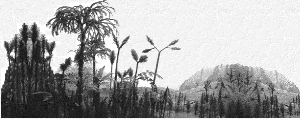

 |
|
 |
| Rhynie doubtlessly
ranks among the worlds most important fossil plants localities because it is
the oldest locality with a completely preserved land flora. Plants are
anatomically preserved, including many
life stages and growth forms with only a very low preservation potential. In this
respect this fossil lagerstätte can be considered as a palaeobotanical
equivalent of famous localities like the Burgess Shale.
Because of the excellent preservation, mostly of material in situ, the Rhynie Chert is one of the very few fossil ecosystems that is known in such a detail. Interactions between different life forms, such as symbiosis, parasitism, feeding and the influence of abiotic factors can be reconstructed. Moreover, the exquisitely preserved anatomical remains form a sound basis for palaeophysiological research. The Rhynie Chert thus provides a unique picture on the very early history of life on land. Although the Rhynie Chert biota has been studied for almost a century now, exciting new discoveries are still being made. On the other hand also new questions arise. From several perspectives the Rhynie Chert biota is of primary importance. The very well preserved Rhynie Chert flora plays a key role, because they form a good basis for comparisons with other, more common and less well preserved compression floras. |
 |
| Right: Scheme showing relationships between different types of
organismes
known from the Rhynie Chert, their interactions, aims and approaches of
Rhynie Chert ecosystem research.
Green arrows = symbiosis; red arrows = parasitism / feeders on other, living organisms; blue arrows = decomposition and decay; grey arrow = fragmentation, decay and decomposition |
| © Forschungsstelle für Paläobotanik, Westfälische Wilhelms-Universität Münster |
April 2000
|